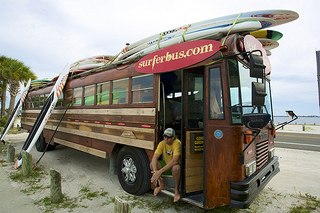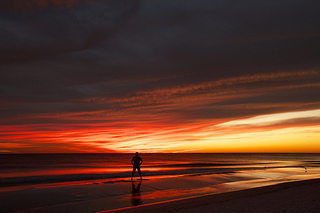Lisa Niver's Blog: We Said Go Travel, page 439
December 21, 2013
Mauritius: Mark Twain’s Heaven on Earth
“Mauritius was made first and then heaven, heaven being copied after Mauritius.”-Mark Twain
Ask anyone whom has been to the small island off the eastern coast of southern Africa what they they liked most on their amazing trip: Relaxing on the famous white sand beaches with remarkably clear water, embarking on a fabulous hike all over the island, rock climbing or the amazing activities offered at sea, such as deep water fishing, swimming with dolphins or sea kayaking. With the mind-boggling array of activities on this small island, there is always something to do for everyone. No matter what your attitude is while visiting this tropical paradise, Tropical Attitude Mauritius has always had the best attitude on the island.

Mauritius from the air, courtesy of Google Images
Mauritius is a small island east of Madagascar that is twice the size of Hong Kong but with only 1 million people. Approximately 85% of the population lives in the capital, Port Louis and it’s suburbs around the city. This means lots and lots of pristine jungle for hiking in the center, unexplored white sandy beaches for lounging around and crystal clear waters for snorkelling and other water activities. With the lack of people and the abundance of open space for recreation all adds up to a truly relaxing and one of a kind experience that you can only experience off the coast of Africa.
With a monthly average temperature that fluctuates between 21-27 degrees Celsius (70-80 degrees Fahrenheit) and average humidity at a constant 82%, Mauritius is obviously a destination that is popular to visit year-round. A constant tropical sea-breeze blows over the island, meaning fresh air is always circulating and because the island is in the middle of the ocean away from any land mass, there is hardly a trace of any pollution. The lack of pollution coupled with near perfect weather year round means you can come here at anytime and are almost guaranteed a great time. It rains on average 9-10 days per month year round, with each downpour lasting no longer than an hour. Afterwards, the clouds disappear and the sun comes out, which guarantees a beautiful rest of the day and more than likely a more than spectacular sunset.
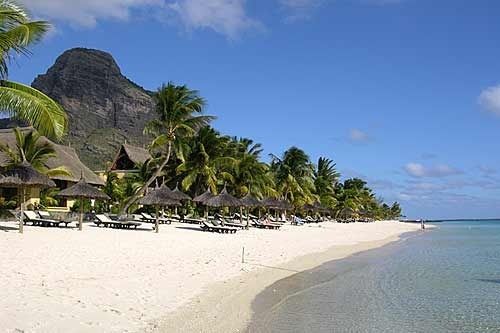
Port Louis Beach, courtesy of Google Images
Clearly, Mauritius is a destination that is sure to sweep you off your feet with the numerous natural recreations available throughout the island. There are activities for every kind of traveler that comes to this natural paradise. Honeymooners often like to soak up the sun on the beach or go out for a night out at the local bar or tavern. Families are often found hiking in the jungle interior, snorkelling in the clear waters or taking a tour to swim with the dolphins. Backpackers whom stop off here on an around the world trip are often found all over the place. With all the activities abound, Mauritius will surely impress even the most hard to impress.
The post Mauritius: Mark Twain’s Heaven on Earth appeared first on We Said Go Travel.
Nomadic Samuel: #79 Top 100 Travel Blog List
We Said Go Travel is on the Top 100 Travel Blog List at #79! In September 2013, we were first added to the list by Nomadic Samuel at place #97. See it yourself: CLICK HERE!
Many thanks to all the efforts of Nomadic Samuel who runs this list.
Here is how it works:
 “Welcome to the top 100 travel blogs (single author, couples and family sites) as ranked by Alexa, SEMRush, Domain Authority & Page Authority indicators. This list was compiled tracking hundreds of independent travel sites. The top travel sites that made this list are ranked according to Alexa (25%), SEMRush (25%), Domain Authority (25%) and Page Authority (25%) indicators in an attempt to highlight some of the best travel blogs. In total, four different metrics are used in the equation from three different independent sources.
“Welcome to the top 100 travel blogs (single author, couples and family sites) as ranked by Alexa, SEMRush, Domain Authority & Page Authority indicators. This list was compiled tracking hundreds of independent travel sites. The top travel sites that made this list are ranked according to Alexa (25%), SEMRush (25%), Domain Authority (25%) and Page Authority (25%) indicators in an attempt to highlight some of the best travel blogs. In total, four different metrics are used in the equation from three different independent sources.
My list is done entirely by ranking numbers and does not involve my personal opinion in any way, shape or form.
The list specifically measures the external link profile of sites using Domain Authority & Page Authority along with Alexa and SEMRush to determine sites levels of traffic, popularity and results in the search engines.”
Nomadic Samuel says:
Lisa Niver Rajna and George Rajna are the collective creative genius behind We Said Go Travel global travel community site. As co-authors of Traveling in Sin they’re also accomplished writers and speakers with extensive around the world travel experience. Given their versatility in skill-set and passion for travel it’s no surprise they have one of the most accomplished travel blogs around today. (Ranking #79 December 2013, #97 September 2013)
Want to Learn More about Lisa and George?
Check out our Memoir, Traveling in Sin at Amazon.com!
Traveling in Sin is a HOT NEW Release on Amazon! from Lisa Niver Rajna
The post Nomadic Samuel: #79 Top 100 Travel Blog List appeared first on We Said Go Travel.
Grand Canyon, USA: Nature’s Grandeur
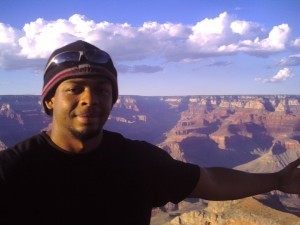 What’s a great way to end a summer? How about a road trip?
What’s a great way to end a summer? How about a road trip?
Three college roommates, with two weeks of unconstrained time ahead of us, sat and contemplated an idea made on a whim.
“That’s a great idea, actually!”
A single confirmatory response was enough to form a consensus. We did, however, saw a need to discuss logistics, and through some deliberations we decided to make visits to major natural sites.
We flew to Chicago, to a roommate’s home, and spent a day filling our roommate’s Chevy Cavalier with an old tent, bags of chips, water, and stacks of beef jerky, among other consumption items. We planned a two week trip that would take us through the American Mid-West, down through Wyoming, then across to California, down the west coast, and across to Arizona before traversing back to Chicago. 2 weeks, 15 states, several majestic sites, and 1 awe inspiring encounter with one of nature’s masterpieces – the Grand Canyon.
Remarkable as the other sites were, this one stood above them. Expansive in size, breath-taking in view and awe inspiring in thought. The canyon greeted us with its many sanguine ridges. The Grandview Point provided our first gaze upon the sheer span and depth of this creation. We were saturated with awe, which had us staring for minutes on end, with a child-like sense of wonder. Nothing could prepare us for this overwhelming presence, which gave such life and character to what may appear to be just a collection of sedimentary deposits. We decided to descend and see how much of this masterpiece we could explore.
We entered the Bright Angel Trail, and passed through a stone tunnel which appeared to be a hole dug through a ridge to facilitate the trail. As we passed through the tunnel we encountered a park attendant sitting in khakis, apparently writing in a log book. He greeted us and solicited information on our hiking experience, of which we had virtually none. He inquired about our water supply and informed us that
“…the ascent is about twice as long as the descent.”
This he made very clear to us. I imagine he was there to keep track of the trekkers on the trail. Certainly this canyon had the bowels to devour inexperienced trekkers.
The trail was easy on the descent, despite the scorching heat and the arid climate. We meandered down for about an hour and a half, before we realized that our water supplies needed to be replenished. We felt we could go further, but I reminded my friends of the park attendant’s advice.
“At this point we would need three hours to get back up.”
We were some distance from the trough of this trail; however, we were clearly not prepared for the full journey today, so we decided to ascend at this point. This would prove to be a prudent decision, for the journey up would surprise us with its difficulty.
The descent was easy, and the points that were easiest (steepest) would be the most difficult during the ascent. We sauntered down and did not stop at any point, but gazed mindlessly at the living tapestry that surrounded us. However, on the ascent we would need several points to stop and stretch our legs. At these points we had even more time to take in the picturesque panorama. No matter how many times we looked up, down and around, the feeling was always:
“Wow.”
About half-way back up the trail and the feeling of wow was coalesced with a feeling of ouch. Our quads and calves began to burn, and we now had to rest at smaller time intervals. The Grand Canyon would not just woo us, it would also work us.
We continued to ascend, stopping and stretching as we needed, until we came to a pipe stand. We refilled our bottles, drank and refilled our bottles once more. Then we came to the final left turn, and we passed the park attendant once more. We glanced at each other, and I suspected he realized we bit off more than we could chew. Well, at least he was able to check us out of his log book. That was good for him, and very good for us.
We went through the rock tunnel once more, and now we were back on leveled ground. We stopped to stretch for the last time, and then took another long, deep look at this majestic creation, crafted from nature’s hand. So majestic was this living art-form that I must revisit here. Next time, however, I will not just go deeper down into the body of this extraordinary being, but I will also make sure I am well prepared for the ascent back to normalcy.
About the Author: Robert Stewart. I am currently a MSc level student in Finance, with a keen interest in expressive writing. I have had several opportunities to visit exciting and interesting places such as the Highlands of Scotland, and several great natural parks and sites in the USA. The presence of the Grand Canyon is still etched in my mind, and I enjoyed writing on this experience. I anticipate doing more travels in the future, and sharing my encounters via the written art form.
The post Grand Canyon, USA: Nature’s Grandeur appeared first on We Said Go Travel.
December 20, 2013
Bradenton, Florida: Ain’t Nothing Like the Real Thing
Oh, the places they stole.
Four times this year I’ve been to the canals of Venice, without ever setting foot in Italy. In Vegas, Macau, Qatar and where I live, Venice, California, there are facsimiles of the famous waterways, only cleaner, shinier, and without the creases of deep history.
Theme parks, made-made-islands, cruise ships, old quarter facades, entire cities fashioned to appear as someplace else. It’s hard, these days, to find a land that has escaped the allure of reincarnation.
Many years ago, after making first descents of a number of wild rivers around the world, I was invited by Busch Gardens in Tampa, Florida to join a media event, the launch of their Congo River Rapids Ride. Some P.R. visionary had concocted a trope in which George Plimpton, the famous “participatory journalist,” and I would make “the first descent” of the Congo River in Florida, with hundreds of media reporting. It was such a circus of counterfeit adventure that I felt I needed a shower after being splashed by the chlorinated Congo. It turned out Mr. Plimpton felt the same way, and as we left the Gardens he turned to give some advice. “If you want to experience the real thing, head over to Bradenton.”
The Bradenton Area, on Florida’s Gulf Coast, is the enemy of the artificial. It includes the town of Bradenton, Palmetto right across the Manatee River, Ellenton, the barrier island of Anna Maria, and a portion of Longboat Key, all part of Manatee County. Somehow this area survived the waves of development that washed away most of Old Florida, and seems to still float in a time when people didn’t just live, but flourished, before air conditioning, theme parks, fantasy leagues, Gangnam Style, and Twitter.
Finally, a decade after George Plimpton’s passing, I decide to explore this place that missed the boat to Make-Believe. There are no hotels themed as St. Mark’s Square, Egyptian pyramids or pirate ships, but there is an impressive range of retreats, from century-old B&Bs to beachside resorts to luxury inns, private residences and downtown boutiques.
I find my way to the pet-friendly Courtyard Marriott, right on the Riverwalk, a throwback to the tow-paths that pulled barges up the Manatee River, delivering goods and gadgets to King Wiggins’ Store. It’s a sinuous two-mile stroll with the rolling river on one side, and a bright assortment of activities on the other, including porch-like swings, volleyball courts, splash fountains, botanical gardens, picnic lawns, and a Team Pain skateboard park, strategically spilled in front of a hospital.
At the western edge of the walk, past several manatee statues, beyond a plaque proclaiming Bradenton “The land of your heart’s desire,” I turn inland a few steps to the South Florida Museum, largest natural and cultural history museum on Florida’s Gulf Coast. It’s a coffer for erstwhile eras, and features a creature that seems from a gentler time: Snooty, oldest known manatee in the world.
Snooty was born when the first monkey astronaut was launched into space; The Ed Sullivan Show debuted; and The Cleveland Indians defeated the Boston Braves to win the World Series. It all seems like yesterday here, except perhaps when comparing the economics. The average cost of a new house at Snooty’s nativity: $7,700.00; a new car: $1,250.00; a gallon of gas: 16 cents; a movie ticket: 60 Cents.
But, Snooty hasn’t changed, except for a few added pounds, and a better pool. He has the same Wilford Brimley snout, the same rounded body and flat tail, and the same ageless appeal. He’s beautiful, but not in any classic definition of the word. It’s hard to believe sailors, even after months at sea, once mistook manatees for mermaids.
Here, in his 60,000 gallon pool, begirds the celebrated lumpy charmer, closest living relative to the elephant, and official mascot of Manatee County. At 65, the boy seems to be enjoying the retired life, shamelessly sashaying about, waiting for lunch. He eats about 80 pounds of Romaine lettuce a day, sustaining his 1,000-pound body. His diet and spa-time seem to have done him well. The average manatee lives only to about 13, due to mostly man-made threats, such as boat propellers, loss of habitat from coastal development, poaching, errant fish hooks and crab trap lines, and cold weather, all the more common with global climate change.
Snooty shares his tank with two fresh-faces, Longo, rescued off of Longboat Key, and Cheeno, rescued in the Caloosahatchee River, both suffering from “cold stress syndrome,” a condition akin to frostbite in humans. The Museum serves as a second-stage rehabilitation facility, and provides temporary home for the new manatees while they heal. So far, Snooty has fostered 26 manatees that needed special care until able to be released back into the wild. The manatee is an endangered species–less than 5000 survive– and looking into Snooty’s whispered, trusting eyes it is impossible to not become a rooter for the mammal’s rights to well-being.
After tarrying with Snooty for a spell I wander around the rest of the museum, eventually stepping downstairs, where I meet Jeff Rodgers, Director of Education. He is delighted to show me a showcase honoring The Culture of Shell. There are replicas of middens, trash piles of shells left by early Native Americans, and, he says, “You can learn a lot about somebody by looking through his trash.” Poor soil notwithstanding, the original Indians discovered the abundance of shells allowed them to create technologies that gave identity, and provided everything they needed.
With the first settlements, the men went out in dug-outs seeking elusive big-game– sharks, manatees, large fish–while the women and children were in the shallows harvesting oysters and clams, conferring the community a reliable protein source. “Once you’ve reached that level where subsistence is not an issue, and you move into surplus, then you start to see art, and ideas expressed through aesthetics.”
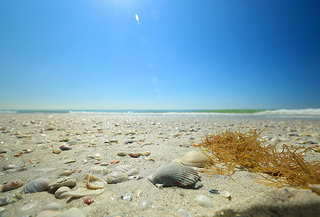 The shells that make up the Gulf Coast are responsible for everything here today, Jeff says. It started with a culture that defined itself by extracting resources from the sea. The shells provided food in an infertile area, and emerging from that state of plenty, the culture evolved to exploit shells in fashioning weapons, making utensils, creating art, and even spirit houses. And that arc of the shell continues today. Who can resist plucking a shiny shell from the sea-swept shore?
The shells that make up the Gulf Coast are responsible for everything here today, Jeff says. It started with a culture that defined itself by extracting resources from the sea. The shells provided food in an infertile area, and emerging from that state of plenty, the culture evolved to exploit shells in fashioning weapons, making utensils, creating art, and even spirit houses. And that arc of the shell continues today. Who can resist plucking a shiny shell from the sea-swept shore?
The shell exhibit inspires me to collect some on my own, so under a coral pink sky the morning next I drive the bridge to Anna Maria Island, and take my good time shuffling up along the fine-grained beaches, an eight-mile string of bone-white sand that might be called the anti-Miami Beach….no neon, high-rises or showboats here. The highest thing is a palm tree, with an osprey on top. I begin on Longboat Key at the Mar Vista Restaurant, across from Whitney Beach, under a spreading buttonwood mangrove. I surrender to mullet and stone crabs, tide-to-table fare, pulled in just minutes ago.
Then I cross the span to Anna Maria, and dig my toes in the soft sugar at Coquina Beach. The sand seems to get even better, though, as I make my way north, along Bradenton Beach, to Manatee Beach, Holmes, Anna Maria, and ending at the secluded and somewhat secret Bean Point at the very northern tip, named for George Bean, first permanent resident of Anna Maria Island. Castled in the kelp are jut-eyed little crabs, a world of inch-high devils. The wet sand here is so sumptuous it’s like Julia Child’s butter.
Meandering back down the coast a ways I stop for dinner at the Sandbar Restaurant, smack on the beach. Ed Chiles, the owner, stops by for a drink and a nosh, and we watch as an almost nuclear sunset shatters the sky. “Like my exterior design?” Chiles asks to an audience too transfixed to answer.
I have a couple of sons, one 19 and one 6, so the next day I decide to check out what might be available for families, as am now thinking of returning with the brood.
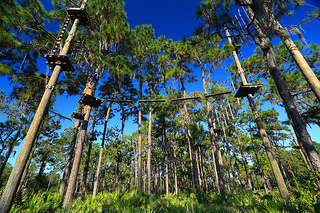 The first find is a place called TreeUmph!, an aerial sandbox restricted for kids between the ages of 7 and 70. Sprawled along 14 wooded acres, it features wobbly bridges, bungee swings, and a 650-foot zip line. At first blush it seems the height of absurdity, but then, after a couple of Tarzan yells, it seems the triumph of spirit over gravity.
The first find is a place called TreeUmph!, an aerial sandbox restricted for kids between the ages of 7 and 70. Sprawled along 14 wooded acres, it features wobbly bridges, bungee swings, and a 650-foot zip line. At first blush it seems the height of absurdity, but then, after a couple of Tarzan yells, it seems the triumph of spirit over gravity.
Next I head over to a giant igloo off I-75. It’s the 113,600-square-foot Ellenton Ice and Sports Complex, the place where Olympic hopefuls practice, and where anyone can escape the 75 degree weather outside and cool down with a glide around the rink. I reach for the analgesic heat rub just watching the elite figure skaters camel spin, axle, lutz and swizzle in front of my envious eyes.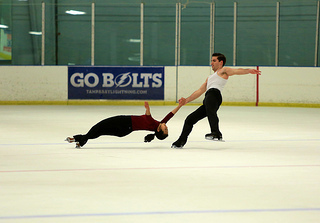
Then I motor over to the Anderson Race Park in Palmetto for a few spins in a go-kart around the mile-long track. Ever since I broke my arm in an unauthorized go-kart race in high school I’ve stayed away from the open-decked vehicles, but the sport and the conveyances have evolved so they are now safe enough for school. That’s who I end up giving a run for the money… twenty-five teens from the Manatee School for the Arts taking a course on “the Physics of Motorsports,” the only such class of its kind in the country. I’m a wimp compared to these guys, and even though I manage to stay inside my kart, the GoPro attached to my bumper goes flying off during a sharp turn. Nonetheless, I take the trophy for coming in last place.
I make a quick stop at a place where anyone, even Tom Hanks, can enjoy the pirates, McKechnie Field, the stadium where the Pittsburgh Pirates do their spring training. Then, with a couple of local saltwater cowboys, disciples of the net, I charter a T-craft and cruise to the west of Anna Maria Island. Just offshore we float over several manatees, vivid with prop scars, and then past several dolphins, who seem to flipper us off, before reaching deeper waters, where I promptly seal the deal by pulling in a holy mackerel, a huge king. I want to be very clear on this, since no one asked. I did not break the mackerel fishing record with this outing.
I finish the afternoon with Shaun Dutshyver, a true Florida cracker, seventh-generation native and owner of the Surferbus, a retired school bus refurbished with woodie paneling. It’s parked like a food truck alongside Manatee Avenue, packed with surfboards, kayaks, and a tumble of candy-colored paddles.
Shaun takes me paddle-boarding into the 487-acre Robinson Preserve, a trip through the leafy grace of mangrove tunnels into the blueways of the Perico Bayou. There are birds galore, 100 species or so, from black-bellied plovers and roseate spoonbills to wood storks, great blue herons, snowy egrets and briefs of pelicans. And there are some 75 species of fish, including mullet, several of which make flying leaps attempting to hitchhike on my board. It’s one of those places where I pole ahead of myself in perpetual expectation of miracles, and they seem to come true.
The next day is turn-back-the clock day; not the daylight savings crank, but the century savings adjustment. Under manatee-shaped clouds (after a few days here everything seems to shape shift into manatees) I head over to Manatee Village Historical Park, and meet Cathy Slusser, Director of Historical Resource. I pull out my wallet at the entrance, and she chides, “Put that away. Admission is free here.”
Entering the tree-lined field is like falling into a vortex. A few paces and I’m in the middle of a collection of 19th century buildings, including the 1860 Manatee County Courthouse, the 1887 Union Congregation Church, a one-room school house from 1908, the King Wiggins General Store, established in 1903, the Apple Store of its day, with the first telephone in the region, and a mill where cane syrup was made, (a horse hitched to the end of the sweep walked in circles grinding the stalks.) Cathy, who wrote an historical novel set in pioneer days Manatee County, “From a Heavenly Land: Eliza’s Story,” tells me one of her favorite tales of the era, when one Ellen Clark, a mid-19th century homesteader, lost Charles, one of her workers. He wanted to be transferred to his family home in New York for proper burial, so she stuffed his body in a whiskey barrel, nailed the lid shut, and put him on the first ship north. “He was the first Manatee County man to be pickled,” she shares. It’s all worth the price of admission, even at ten times the fee.
For lunch, I take the wayback machine to the Cortez Fishing Village on the blue-green waters of Sarasota Bay, oldest surviving fishing village in Florida, dating from at least 1880. It has survived hurricanes, wars, depressions, the thrusts of fashion, and government regulations. Cortez isn’t a living museum – it is the real fishin’ thing. That’s the hook. No strip malls, chains, car lots or condos here. The place has eddied out of the future. The old white homes are elevated off the ground (pre-glycol air conditioning), have front steps, screened-in porches, and barnacled boats parked out front.
There is no doubt the most authentic eatery in this most authentic of villages is the Star Fish Company, a dockside joint that dates to 1923. Mullet, grouper, stone crab and shrimp are cleaved, gutted, grilled, fried, blackened, sautéed, and served in plain paper boxes, along with cornmeal hush puppies, coleslaw and French fries. Yet, despite the pedigree, there’s something fishy here, and the owners would appreciate the bad pun… signs groan all around the picnic tables, such as:
“Why did the mermaid stop dating the clam? He was too shell fish.”
“Seas the Day!”
“Time flies when you’re having rum.”
“Sometimes I wake up Crabby—but mostly I let her sleep in.”
“Arrive a stranger; leave even stranger.”
And my favorite, “Give a man to fish, he will eat for a day. Teach a man to fish, he will sit on a boat and drink all day.”
Every dish here comes with a side order of puns.
The next day is my Green Day. Turns out Bradenton is not just authentically unspoiled, but it is honestly green. I begin on the north end of Anna Maria Island, along Pine Avenue which bills itself as “The Greenest Little Main Street in America.”
I begin a stroll down the sand sidewalk (no toxic concrete here), and make a “resistance is futile” turn into Anna Maria Donuts, a designer bakery with hand-dipped gluten-glutted doughnuts so decadently good the place can’t be eco-friendly. But it is. It’s housed in a cluster of old, reborn buildings that together make up the “Historic Green Village,” a Net Zero Energy project with Platinum LED certification. There are rainwater cisterns that flush toilets; storm water that irrigates native landscaping; an air conditioning system that cools with underground water; solar-heated hot water; free recharging stations for electric vehicles; a fully air-conditioned jail with no doors, windows or roof; a vegan taco shop; and AMI Outfitters, “where men shop for gear; and women shop for men.”
For the dénouement of the trip I decanter east, to the far reaches of Manatee County, to the greenest vinery in America, Bunker Hill Vineyard and Winery. Wine in Florida? An eco-vineyard? Who knew?
I was born in a Quonset hut in New Haven, Connecticut…they were popular housing units through and after WWII, but have since joined the architectural heap of history. So I’m always delighted when I come across one that’s in use. And here, at the end of a dirt driveway, is one of the iconic rounded steel huts, the portal into Bunker Hill.
Outside the door are piles of empty wine bottles…looks like someone had quite the party last night. Inside, though, are even more empty bottles, neatly stacked on maple wood shelves. Sitting at a long tasting table are owners Larry and Lenora Woodham, refugees from the corporate life, now living their green dream.
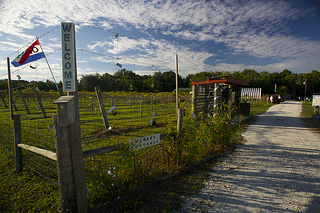 Lenora has to run to the vet to pick up the cat, so Larry offers to show me around. First, though, he explains the empty bottles. “We’ve never bought a bottle for our wine.” All the wine the Woodhams make goes into recycled bottles, all contributed by past customers, some of whom drive long distances to make the deposits. Out back is an intern scraping the labels off of old bottles.
Lenora has to run to the vet to pick up the cat, so Larry offers to show me around. First, though, he explains the empty bottles. “We’ve never bought a bottle for our wine.” All the wine the Woodhams make goes into recycled bottles, all contributed by past customers, some of whom drive long distances to make the deposits. Out back is an intern scraping the labels off of old bottles.
But the Woodham sustainable practices go well beyond the recycled bottles. The vineyard drip irrigation system is solar-powered, only real oak corks seal the bottles (and used corks are sent to be recycled into cork tiles,) and all Bunker Hill bottles are sealed with genuine hot wax.
All the wines are handcrafted and unfiltered, never blended, fermented with the skin of the grape. “The best wines of this planet are unfiltered,” gleams Larry.
Larry says most vineyard owners today filter their wine, and by doing so, cut a year from the fermentation process, allowing quicker vine-to-shelf delivery, helping the bottom line. Larry believes filters compromise the natural flavor, and often add undesirable additives, such as dried blood powder, gelatin, fish bladders and sugar. So, he and Lenora choose to add the extra year to make their wine as it was done in Europe centuries ago.
I follow Larry’s very small carbon footprints around the grounds.
Radiating from a seep spring are vines of Florida Muscadine, growing as far as the eye can see. The grapes are handpicked, and brought to the pressing room, where they are hand crushed. The residue juice is taken into the adjacent climate-controlled fermentation room, where it sits for a couple weeks. Under the fermenting containers are large glass ampoules where the liquid is hand-siphoned, and eventually transferred into the 55-degree Cave, where the wine ages at least a year before being bottled, then hand labeled.
Back at the tasting table Larry pours some samples of the fresh fruit wines that come through his scullery, from banana to key lime to cherry tomato and black and green tea. Ecotourism never tasted so good.
What an authentic man, Larry is, a thoroughbred Floridian, and an archetypal personality for Manatee County. After all, it turns out, his great great Grandfather William Iredell Turner founded Bradenton.
I step away, at a pace more unhurried than when I arrived. Slow still gets you there.
##
The post Bradenton, Florida: Ain’t Nothing Like the Real Thing appeared first on We Said Go Travel.
Paris: A Home To Call My Own
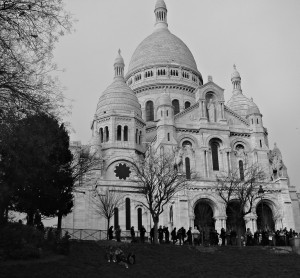 I remember it as if it were yesterday. Such an old saying yet no truer words have ever been spoken. Unless they were all lies. In this case the memories are fragments, growing shorter and shorter as years pass, but the happiness even in the crustiest corners of my mind remains true.
I remember it as if it were yesterday. Such an old saying yet no truer words have ever been spoken. Unless they were all lies. In this case the memories are fragments, growing shorter and shorter as years pass, but the happiness even in the crustiest corners of my mind remains true.
It was an unseasonably warm day in Paris as I stepped out of a building that looked like it belonged in a far off land where dreams are made. There wasn’t a cloud in the sky. I meandered the city streets on that quaint afternoon, stopping at a favorite boulangerie for nourishment as I walked along. Soon my time would be up. In a few short weeks I would be on a plane home. Home. I wasn’t even sure what that meant anymore. Certainly a mere four walls could in no way define such an exasperating word.
The past ten months I had grown and stretched, laughed and cried and fell in love with Paris in ways I don’t think I will ever be able to put into words. Paris the city of light, love, lust, wonder; a city of tragedy and perseverance. It all past by in a flash and I desperately ached to hold onto it a little longer. I had found my place and I was so utterly content. The thought of returning “home” didn’t seem right. That day would be spent in the park with friends drinking wine while we talked of life in all it’s cliche forms. I recall it vividly and yet much like a puzzle I put together the pieces each time I recall it. There, where I am no longer. A dream and a story that are mine and a gift. Walking those cobbled steps in the wake of Hemingway and Miller I can’t fathom the thought of another time or place. I can’t help but think of Henry’s words, underlined and worn:
“It [is] his Paris. A man does not need to be rich, nor even a citizen, to feel this way about Paris. Paris is filled with poor people – the proudest and filthiest lot of beggars that ever walked the earth… And yet they give the illusion of being at home. It is that which distinguishes the Parisian from all other metropolitan souls.”
The day I arrived in Paris there was no fear, only a feeling that I was exactly where I was supposed to be. I adapted to life easily never discouraged by miscommunication or the loneliness that can come living in a city much less abroad. The characters, the people I met intricately woven into a tale I had yet to know the significance of. Even now years later I still pull from that time, lessons that will remain with me always.
As the plane hovered over the Atlantic I cried tears of sorrow bidding adieu to my beloved metropolis. It is only in hindsight that they were just as well tears of joy. The gratitude I feel for having the chance to study and live in Paris is immense and unquestionable. It’s been said how often we take things for granted, privilege can blind us from the simple beauty life has to offer. The experience may have been priceless but there was a cost and it was gifted to me.
Paris is layers upon layers of history and culture. Mystery and adventure can await round any corner. Filled with some of the most iconic monuments in the world Paris can be an enviable destination and tourist trap. The Eiffel Tower can certainly lose her majesty in the wake of an elevator filled to the brim with people simply wanting the picture rather than the experience. But then you find yourself quietly sitting on the six line late one evening and just as you make out the tower it lights up, awake and alive and it simply takes your breath away. Paris like any city can be daunting and robust. Too many cafes to count until you stumble upon the most perfect crepe and the world makes sense again. Versailles in all it’s opulence is a sight for sore eyes. It’s easy to see how one might not get along with such a city but like any new place it’s a matter of finding balance between the beauty and the beast.
Paris can feel incredibly harsh until it is holding you in it’s warm embrace. My time there is one I reflect upon not just for the lessons it taught me, but for the humbleness it instilled within. For the splendor and knowledge of travel and worlds unknown. Now, even with an ocean between us I take comfort in the memories tucked away, the memories of home.
About the Author: Jessica Ann is a wannabe writer and a wandering soul. When she isn’t frolicking around one destination or another she is most likely figuring out life with the Golden Girls as her guide, which basically means she’s watching TV. Oh and more on her blog.
The post Paris: A Home To Call My Own appeared first on We Said Go Travel.
Christmas in The Philippines – Part 2
This is Part 2 of a guest post by Johanna Castro: Click here to read Part 1
It’s been said that The Philippines was once a convent, but that it was converted to Hollywood, and no more is this true than at Christmas when lights flash and sparkle from rooftops and houses and palm trees, as if they belong to a movie set.
Santa Claus won’t find any chimneys to go down at Christmas because it never gets cold enough for a log fire. Obviously there is no snow, and there are palm rather than pine trees, but that doesn’t mean the country is short on Christmas traditions.
One of my favourites is the tradition of the parol.
The Star of Bethlehem
Parols, or star lanterns represent the Star of Bethlehem. These lanterns are a little like giant kaleidoscopes and they sparkle and flash from houses, shrubs, doors, hotels, shops and skyscrapers. Some are gigantic but even the most humble dwellings will generally display a home-made parol.
We had one that we’d put up every year in our garden, much to the delight of our children who would beg us to take them out at night to watch it change colour, and then we’d have to walk and view all the other Christmas decorations and parols in the suburb.
The Nativity Scene
I used to love searching for Christmas decorations each year, not only at the city stores but at the markets, and another important religious icon we bought we still have today – it’s a tableau depicting the Nativity scene, or the belen, meaning Bethlehem in Spanish.
Christmas really arrives on Christmas eve when mass is held at church, after which families celebrate at home with Noche Buena, the good night feast, and this is the time when Christmas gifts will be given.
Outlying islands, like Puerto Galera below, one of our favourites, may not be necessarily Christmassy on the beaches, but in the villages it will be another matter altogether.
For many Filipinos Christmas is a time of rebirth and renewal.
Typhoon Haiyan
This year, my thoughts are with all those affected by Typhoon Haiyan, and I truly hope that as devastatingly sad as this time has been that Christmas will bring hope into the hearts of all those who have suffered or are still suffering.
We were very good friends with a very special woman who set up a foundation to help the youth of the Philippines and this organization is called The Springboard Foundation Springboard is currently supplying supplies and resources to those who have been affected by the typhoon, and I encourage anybody to donate, however small an amount.
Thank you so much for reading Christmas in the Philippines, if you would like to read more, please pop back to Part 1 in this series.
But now, I think it’s time to wish you …
Maligayang Pasko – Merry Christmas!
Bio: Johanna Castro is a travel writer and managing editor of two blogs. Her “Travel Blog ZigaZag“ inspires people to “Live for the Moment, Love Adventure and Do Something Awesome,” and “Lifestyle Fifty” is for fun, feisty, funky women of a certain age. To learn more about Blogging download her free E-book “ How to Be a Well Fed Blogger” by signing up for her Newsletter Jo’s written for 40+ print, and around 20 online publications, has self published a children’s novel in support of an orphanage in The Philippines, lived in 11 different countries, is married to a geologist and has two well traveled, grown up children.
The post Christmas in The Philippines – Part 2 appeared first on We Said Go Travel.
Norway: A Glimpse between Winter and Spring
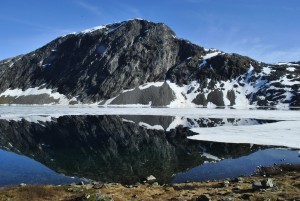 In my travels, among many things, I also look for magnificence, it activates my life inspiration. The world’s various forms of beauty are sometimes shelters from these continuous human failures, from the human despair and from the the destruction of beauty itself. Sometimes they are triggers for virtuous actions. Travelling, being also an exploration, allows to come in front of magnificent things: the hands of a woman resembling flowers in a Thai dance or representing the earth in a Norwegian countrywoman; a flying condor when it shows its wingspan, a majestic elk crossing fearfully the road, the untouched environment.
In my travels, among many things, I also look for magnificence, it activates my life inspiration. The world’s various forms of beauty are sometimes shelters from these continuous human failures, from the human despair and from the the destruction of beauty itself. Sometimes they are triggers for virtuous actions. Travelling, being also an exploration, allows to come in front of magnificent things: the hands of a woman resembling flowers in a Thai dance or representing the earth in a Norwegian countrywoman; a flying condor when it shows its wingspan, a majestic elk crossing fearfully the road, the untouched environment.
Nature’s manifestation is particularly awe-inspiring, the more virgin the deeper the wonder. That is why I love the moment when at the beginning of May I start traveling to Geiranger (Norway) where I will be spending my summer working. When I arrive there it is my favourite time of the season: the 240 inhabitants of the village are not hosting any tourists yet; the winter season is giving space to spring and this transition is like an awakening after a long sleep.
Last May some of my closest friends and I decided to devote some time to deeply enjoy this unique time of year. We went for a camping weekend in the middle of nature, not far from the village. The place is called Flydalsetra, it is an old abandoned summer farm, about half an hour walk from the last inhabited houses. The purpose of the escapade was allowing some time to ourselves. The time that we miss during the busy season. It was a personal experience in a special place, surrounded by the people with whom we are ourselves. What made that weekend outstanding, a part from the people, was the place.
An awe awaking place.
A minute spot in the universe where the beauty of nature prevails so much that it was able to astonish and inspire me. It was an harmonious painting, in which the combined effect of every single detail was creating a natural wonder. The peaks, which were still wearing their caps of snow, were making a perfect background; a valley, cut by a fierce stream, originated at the feet of the mountains and it seemed a delimited and vast space at the same time. The timber line clearly distinguished the graze fields of the upper part of the dale and the underlying woods. The light was extremely bright and the sky cloudless, it was the reborn luminosity after the dark and long winter. However, the sun was still shy. The winter, still present, was coexisting with the emerging spring creating a game of colours. On the one hand there was the white colour of the snow on the other the yellow, the green and the brown tones that were merging into one tint.
The motionless painting was slowly awaking. The sounds also accentuated the difference between the two seasons: the silence interrupted by sporadic avalanches belonged to winter whereas the tweeting of the birds and the roar of water were associated with the vibrant spring. The swallows danced freely in the sky, having great fun, accompanied by a gentle breeze.
It was the ideal place to just stare at nature’s phenomena, lie down, listen and free your mind. I felt connected with everything around me. First I walked barefoot on the wet soil and then I shocked my feet stepping on the frosty snow. Later I went to the river and its strength, its coldness, its sound had a double effect on me: magnetism and intimidation. I could have watched it for hours learning how to respect it. I also rested watching the swallows and once again I envied the ability of flying.
It was the simplicity, the integrity and the personal contact with this natural manifestation that delighted my soul and for that I felt grateful. The place was denuded by any invasive human presence and this made it possible to stop and listen to wonder; everything stood in its original place or was moved only by natural circumstances and my perceptions broadened. My senses were those of a child experiencing everything for the first time.
When I was there, in the middle of nature, I was feeling great, unconscious of the effect that such a simple experience could have on me in the future. The magic of these places is that they are also enlightening in the time ahead.
While walking back to the village I felt cheerful: that weekend had been a reminder of many important simple things. I had left behind insignificant matters and was ready again to deal with everyday life situations with a little more gratitude. During the working season, when my mind was overwhelmed, I found myself thinking back to that moment in need of that peaceful sense, I found it and it helped. Now even the memory of it makes me feel grateful.
About the Author: Jessica Michele Garcia: I am a freelance writer graduated in Translation and Communication Sciences and in Freelance Journalism. I also work as tour agent and tour guide in Norway every summer. Travelling is my lifestyle: I am now living in Chiang Mai (Thailand). More on my blog!
The post Norway: A Glimpse between Winter and Spring appeared first on We Said Go Travel.
December 19, 2013
New York: Lake George from the Porch
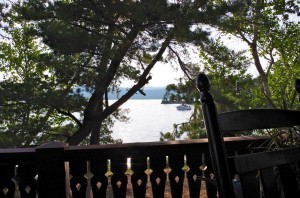
Lake View by Woody Sherman
I’ve been visiting a 100 year old house on the shore of Lake George, New York. It reminds me of the lodges you find in National Parks out west, mainly because of its stacked stone pillars and the design cut into the balusters of the porch railings. Built out of solid materials and with an appreciation for beauty, it’s gracious the way I imagine some future house of mine will be whenever I read something like Southern Living or This Old House.
I’d never heard of Lake George before I married into the family who owns this house. As a University of Virginia alumna and a Charlottesville resident, I was surprised to see the shopkeepers of Bolton Landing prominently displaying their favorite Thomas Jefferson quote: “Lake George is without comparison, the most beautiful water I ever saw; formed by a contour of mountains into a basin… finely interspersed with islands, its water limpid as crystal, and the mountain sides covered with rich groves… down to the water-edge: here and there precipices of rock to checker the scene and save it from monotony.”
How had I not heard of this place?
The beauty and unusual geography stunned me and the stories hooked me. The first year I devoured two books during our visit. One of the house’s previous owners wrote about summers on the lake when she was a child, when steamboats would make stops on Sunday mornings to pick people up for church on the other side of the lake. Longtime park ranger Frank Leonbruno wrote about his 42 years watching out for campers and short-term vacationers, as well as the storied wealthy families who quit New York City for the summer to live on the lake and its islands.
They are old stories, from another time, leftover from another world. Part of what I love about drinking in the stories of the lake along with its beauty is how different they are from any of my own family stories. I come from farming families in Virginia and West Virginia where “summering” meant more work and long days in the tobacco fields.
The house I visit is a relic from that other time and it takes care and looking after. A lot of upkeep goes into our casual evenings on the porch, sipping drinks and listening to the water lap the shore. It’s a relic because it’s a place where the porch takes precedence and spending the evening there is the thing to do.
This is what I love most about the place and why I’m filled with gratitude. I’m tempted to say I “step back in time” when I’m at the lake but it’s not true. We have indoor plumbing and wifi and television. What’s truer is I step off the treadmill, out of the fast lane. I go much, much slower. And I bask in that. The only “goal” once we are there is to enjoy our family and the wonder of the place. We spend more time on the porch than any place else – holding a steaming cup of coffee in the morning when the lake is still glassy and the boats aren’t out yet, enjoying the shade of the porch while reading and napping midday, watching and waving as the campers from YMCA Camp Chingachgook paddle past in their kayaks and canoes, dining and imbibing throughout the evening when the lights from the other shore reflect on the water.
I do love that porch.
One-hundred years is the blink of an eye to glacially-hollowed Lake George. But it’s enough time for a house to learn how to capture my imagination, improbably connecting me to a longer and different story than my own. And even though I never feel like leaving and I always look ahead to the next visit, one week a year is enough to re-set my tired 21st century ways, reminding me what a human pace is and how gracious living can be.
About the Author: Whether it’s a pilgrimage through Israel and Palestine, a weekend camping trip in the Appalachians, a simple car ride to visit family, a massive road trip through the National Parks, wandering the streets of Paris, drinking Guinness in Ireland’s pubs, extended visits to family friends in England, or the recent ritual of returning to the dear spots like Lake George, Deborah Lewis loves travel. Read more on her blog!
The post New York: Lake George from the Porch appeared first on We Said Go Travel.
Nainital, India: Paradise On Earth
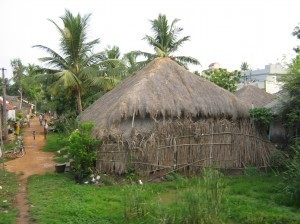 My frozen fingers automatically reached for the neatly packed sweater in my black and white striped bag as the train came to a shuddering halt before the sun had fully risen. The sudden change in temperature from the prickly heat last morning to the chilly mist today was proof enough. We had arrived.
My frozen fingers automatically reached for the neatly packed sweater in my black and white striped bag as the train came to a shuddering halt before the sun had fully risen. The sudden change in temperature from the prickly heat last morning to the chilly mist today was proof enough. We had arrived.
As my tired eyes refused to open wide, after the stiff, sleepless night I spent in my cramped berth, I yawned and let my arms find the comfort of the soft woollen clothing as I wrapped myself up tightly in its lovely warmth. At the call of my friends, who had already freshened up, I slid off the berth and started hopping around the dirty, sticky floor of the train as I began my search for my slippers, trying hard to keep my pink feet pink.
About an hour later, after we had all settled down with our tummies full with bread and omelette, the train finally came to a halt. Grabbing the luggage that was ready on our laps, we descended, our eyes sparkling with excitement.
Situated in Northern India, towards the Himalayas, Nainital is prominently lush with abundant greenery and multiple lakes. Often called the ‘Lake District’ of India, this hill station is famous for its tourist attractions of nature’s splendidness.
Our toes felt numb from the sudden chill that welcomed us on the platform. Surrounded by petty vendors who were selling hot, homemade food or packed up junk items, the railway station resembled what most others in India did. Unkempt surroundings and mixed up smells.
The only difference I noticed, than that at the station back at home, was the whimpering crowds, anxious to get a cup of hot tea. The tea seller seemed to be making the best business on that platform. As the warm, sweet liquid slid down our throats while the icy breeze brushed our cheeks, we sighed in ultimate bliss.
Outside, the entire scenario was different. Back in my city, I would be welcomed by the bustle of the busy roads and the hustle of harried humans. But here, to my pleasant surprise, I found greenery everywhere. I watched as people, fully covered from head to toe with monkey caps, mittens, mufflers and padded shoes, walked around, preferring to commute this way to places close by to taking out their pollution causing vehicles. It made me wish that we did that more back home.
We were made to stand in twos as we walked down to our hotel, looking like happy penguins, where we were greeted by a wonderful treat.
Like the rest, our hotel wasn’t in view. It was situated even higher than we already were. Five hundred steps higher, to be precise. Thus began our unending journey to get to our rooms as we dragged our luggage up the endless flight of steps, our beads of sweat being gently kissed by the cool gushes of breeze.
Our first stop was Ranikhet, meaning ‘Queen’s Field’ situated around 60 kms away from Nainital. A picturesque hill-station, this place is famous for its large acres of pine trees. Carrying two pine cones in each of our pockets and three in our hands, we walked ahead to the best sight we’d probably ever see in our lives. A sight that no camera would be able to capture to perfection. This was a panoramic view of the great Himalayas set among the loveliness of ample greenery and hidden behind cool mist. To compliment this, the pure fragrance of nature left us spellbound. We eagerly took out our cameras but knew that this was one sight worth seeing with the naked eye.
Next in queue was the Naina Lake. Spotting the boats from a distance, we ran towards the water body, unable to contain our excitement. Paying the boatman, we got in and screamed in delight. The boats set off, unsettling the stillness of the clear water, as we looked around, regretting the fact that we only had two eyes to take in the exquisite beauty dotted with plush villas and pretty cottages.
One of the main attractions of Nainital and the biggest wonder for us was that of the ropeway. This connects a trolley that can carry up to ten passengers to the top. In great excitement, we all got in, nervous at the great height and gasping in delight at the astounding gorgeousness.
As night arose, we spread out to do shopping, getting souvenirs to take back to our families. The best one however, was the candle collection. Exquisitely shaped, these wax structures looked magnificent. As we boarded the train back home reluctantly and stared out the grilled windows, all the magnificent sights of Nainital danced in front of our eyes and would continue to do so for many years to come…
About the Author: Shravya Gunipudi is a 20 year old CA Final Student from Hyderabad, India. Writing has been her passion right from a tender age and she has won numerous contests. She also has a blog titled ‘Fictionally Inkspired‘ -
The post Nainital, India: Paradise On Earth appeared first on We Said Go Travel.
Dave’s Travel Corner: Puerto Princesa, Philippines: Lodging, Eateries, and Sites
Thanks to Dave’s Travel Corner for sharing our story about Puerto Princesa, Philippines: Lodging, Eateries, and Sites
With 1,500 people a day arriving to see the sites in and around Puerto Princesa (Philippines), travelers need to know where to stay, what to eat, and where to visit. In the last twelve months, many new accommodation options have opened up including the boutique styledl and Kamia Bay’s lovely resort. Long time restaurant favorites such as Ka Inato and Kina Buch continue to delight tourists and locals alike with tasty Palawan food at reasonable prices. As far as what to do, the top billing in the Puerto Princessa area is the unique and captivating Underground River. However, lesser known gems are worth visiting just outside Puerto Princessa.
Lodging: Tucked along Manalo Extension located a five-minute drive from the airport is the chic boutique Acacia Tree Garden Hotel. Acacia Tree opened in October 2012. Twenty-five rooms are set around a pool. The lovely garden setting makes you feel miles away from any troubles or traffic. The hotel won the Best Budget Hotel in Palawan Golden Globe Award and has the largest room size in the area. For their upcoming one-year anniversary, a butterfly garden is being planned to add to the garden. Guests enjoy billiards, darts and board games in the communal area near the reception desk.
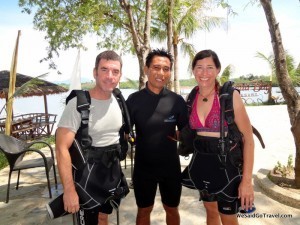 Each room is named after a local plant that grows outside the front door. The blinds are from Binuatan Creations, made at the local weaving station. Everything is carefully thought out and comfortable. Kenneth Cobonpue, a well-known international designer and resident of Cebu, for example, designed the chairs in the lobby.
Each room is named after a local plant that grows outside the front door. The blinds are from Binuatan Creations, made at the local weaving station. Everything is carefully thought out and comfortable. Kenneth Cobonpue, a well-known international designer and resident of Cebu, for example, designed the chairs in the lobby.
Read the full article on Dave’s Travel Corner
Want to know more about our adventures as a couple? Enjoy all of our articles on We Said Go Travel and read our memoir to find out about how we met online and traveled for eleven months in twelve countries while Lisa lost 60 pounds and we got engaged underwater in Koh Lipe, Thailand in January 2009. December 19, 2009 is our 4th wedding anniversary and we are spending it in Langkawi, Malaysia!
Traveling in Sin is a HOT NEW Release on Amazon! from Lisa Niver Rajna
The post Dave’s Travel Corner: Puerto Princesa, Philippines: Lodging, Eateries, and Sites appeared first on We Said Go Travel.
We Said Go Travel
We Said Go Travel is a global community of over sixteen hundred writers with articles from every continent.
Stories are shared with photos and video from a perspective of the transformative power of travel. We Said Go Travel has hosted live and online events as well as travel writing contests around the world. ...more
- Lisa Niver's profile
- 57 followers


